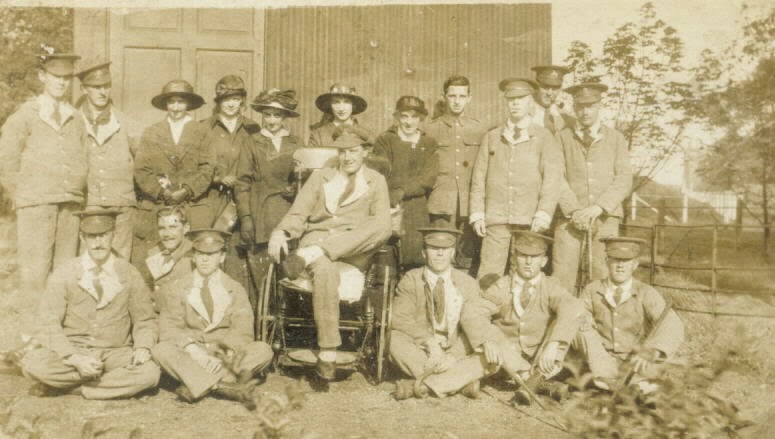O! Canada, Mistress of snows and of mountain,
Tears are the dew of thy prairies to-day;
Thy blood has gushed forth as it were from a fountain,
‘Neath Belgium’s sweet soil thy noble sons lay.
Gallant the “Charge” that made the world-story,
Fierce were the odds, but they knew not dismay,
Ever their fame will reflect in the glory
Of self-sacrifice, as they fell on the way.
(Private
George Gilmore, Tenth Battalion)
I remember my Grampa Dolan as a quiet and peaceful man. He never said a whole lot; was gentle and unassuming - to me anyway. David, Mary Beth, and cousin Kathy, and others may remember him differently. I have a hard time seeing him in combat - and close quarters combat at that. But he was. He saw it. He experienced it. He survived it. It was a place called Kitcheners' Wood.
 |
| Sketch of Battle for Kitcheners' Wood |
The 10th experienced the first ever gas attack, and made a heroic
stand against the German offensive there. The account of the battle is too long
to recount here, but it went something like this. Originally assigned to be a
support battalion, they were called up to fill a huge gap in the line caused by the retreat of the
French troops who received the brunt of the poison gas attack. The decision was
made to counter-attack the Germans. The objective was a small woods, later
called Kitcheners' midnight, within 200 yards of the objective, all hell broke loose. Machine gun and small arms fire
from the front and the left flank mowed the Canadians down in droves. A small
number made it to the woods where there was intense hand to hand combat. By the
end of the day, most of the officers were dead or wounded, and chaos was
everywhere. As the 10th reformed on Friday morning, April 23rd,
only 5 officers and 188 other ranks were left out of the 816 who had gone into
action 6 hours before.
 |
| What was left of Kitcheners' Wood |
Friday was
not as dramatic, but it was a day of fierce fighting as the 10th
fought to hold their positions. They were bombed and shelled all day. On the
third day the 10th fought off an all out attack by the
Germans which was preceded by another poison gas attack. Finally they were
ordered to withdraw, but that was no easy thing. They had to cross over a low
ridge in broad daylight within 100 yards of the German machine guns. Now barely
the size of a company, there were only 3 officers and 171 men left.
They
weren’t done yet. The battalion was ordered back into action reinforcing
another battalion. They found themselves in the direct path of another German
attack, but time and again they fought it off. The Germans gave up on the
frontal attack, but as one man said, “they (the Germans) started to play the piano on
us”, which meant that they had to endure another heavy bombardment. Although
they had picked up two new officers, the ranks were now down to 151 men. When
night came on Saturday what was left of the 10th moved back to the
rear for a hot meal and rest.
The rest
didn’t last long. Just before midnight
what was left of the 10th joined up with what was left of another
unit and were sent to shore up the line in a place called Gravenstafel Ridge.
Sunday meant another day of shelling and fighting. Monday was more of the same.
Finally on Tuesday, April 27th, the 10th Battalion, with
only 2 officers and 117 men left, one of them Grandpa Dolan, pulled back to Ypres to regroup and receive replacements. They were
assigned to guard pontoon bridges on the Canal de’Yser,
and stayed there until May 5th when the Second Battle of Ypres
officially came to an end.
I vaguely remember asking Grampa once about the war. I don't remember learning much other than it was terrible. He did seem to want to talk about it. My Dad remembered his Dad and uncles talking about it as they sat around the living room. Uncle Bruno was there in Belgium and France, in the Machine Gun Corps. Uncle Harry got into it later in the war - in the Dardenelles. Gramma, who saw the results of war as a nurse (more on that later) claimed that Grampa suffered from the effects of the war to his dying day. I don't doubt it. I can't even imagine it.
Who knows, maybe some of Grampa's quiet was reserved for that time he spent, and for those he left behind at Kitcheners' Wood.
Who knows, maybe some of Grampa's quiet was reserved for that time he spent, and for those he left behind at Kitcheners' Wood.
.jpg)




















.jpg)



.png)

.jpg)


.JPG)
.jpg)
.jpg)

